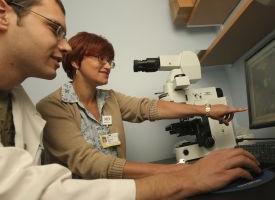Research
URMC Finds Leukemia Cells Are “Bad to the Bone”

Graduate student Ben Frisch and Laura Calvi, M.D.
University of Rochester Medical Center researchers have discovered new links between leukemia cells and cells involved in bone formation, offering a fresh perspective on how the blood cancer progresses and raising the possibility that therapies for bone disorders could help in the treatment of leukemia.
The research, led by graduate student Benjamin J. Frisch in the James P. Wilmot Cancer Center laboratory of corresponding author Laura M. Calvi, M.D., is featured in the journal Blood. It is accompanied by an editorial – “Bad to the Bone” -- written by another leading investigator in the field, Steven W. Lane, M.D., of Queensland Institute of Medical Research. Lane says that the URMC’s unexpected laboratory finding provokes new clinical questions, such as whether screening for osteoporosis could provide any useful information for how to manage acute leukemia in newly diagnosed patients.
Leukemia is a devastating disease that results in the disruption of normal blood production. Blood stem cells (hematopoietic stem cells or HSCs) give rise to all mature blood cells and maintain a balance of self-renewal and expansion. However, in this study, even when leukemia is barely traceable in the blood, leukemic cells implant in the bone marrow and attack the body’s natural process of making healthy blood stem cells.
In this hematopoietic microenvironment, or niche, investigators have been searching for clues. In 2003 Calvi introduced the concept that osteoblasts, which actively work to form bone in this same microenvironment, might have a key role in expanding and supporting the production of normal blood cells. Published in the journal Nature, that study served as the basis for the current investigation.
Frisch began focusing on the impact of the leukemia cells, which reside on the inside surface of bones adjacent to bone marrow activity. Until now, according to the Blood paper, no one had defined the important interactions that take place between leukemia cells and osteoblasts (bone forming cells) and osteoclasts, which continually break down bone. Frisch and colleagues used a mouse model and human leukemia tissue samples to show that:
- The way in which leukemia alters the balance and cycles of osteoblast and osteoclast activity is complex and counterintuitive, and results in several measurable changes to the skeleton.
For example, since bone formation and bone resorption are usually tightly knit functions, researchers expected to see that dramatic bone loss due to leukemia would also be consistent with a breakdown of bone and minerals, or resorption. Instead, they saw a mild increase in osteoclastic cells responsible for bone resorption, suggesting that leukemia uncouples these two bone cell functions. Ultimately, researchers would like to understand more about osteoclasts during the disease process, so that they can perhaps target those cells for treatment.
- In this study, leukemia caused low-level and widespread bone thinning and bone loss, similar to osteoporosis, particularly in the long bones. Preliminary lab experiments showed that treatment with bisphosphonates, a commonly used class of drugs for people who suffer from bone loss, partially restored bone loss in mice with leukemia.
- Leukemia results in the expression of a protein, known as CCL3, which slows bone formation. Thus, elevated CCL3 levels in leukemia make it a tempting treatment target. Theoretically, newer drugs that block the CCL3 pathway might be able to restore the low-level, net loss of bone observed in many leukemia patients. A few drug compounds that act on the CCL3 pathway are under study in early-stage clinical trials, Frisch said.
Another interesting question, the study noted, is the way in which dysfunction in the bone marrow microenvironment might delay a patient’s recovery after chemotherapy, or be the catalyst for relapse.
“Our findings are quite provocative and we hope they will lead to new approaches to promote normal blood production in patients with blood cancers,” said Calvi, associate professor of Medicine. “Because the loss of normal hematopoietic function is the chief cause of serious illness and death among leukemia patients, it is critical that we understand all aspects of how this occurs and find new strategies to accelerate the recovery of these defects.”
Funding was provided by the Wilmot Scholar Cancer Research Award and the Pew Scholar in Biomedical Sciences Award. Co-authors include John M. Ashton, Ph.D., URMC Department of Genetics; Lianping Xing, Ph.D., URMC Department of Pathology and Laboratory Medicine; Michael W. Becker, M.D., URMC Department of Medicine, and Craig T. Jordan, Ph.D., the Philip and Marilyn Wehrheim Professor of Medicine at Wilmot.
# # #


